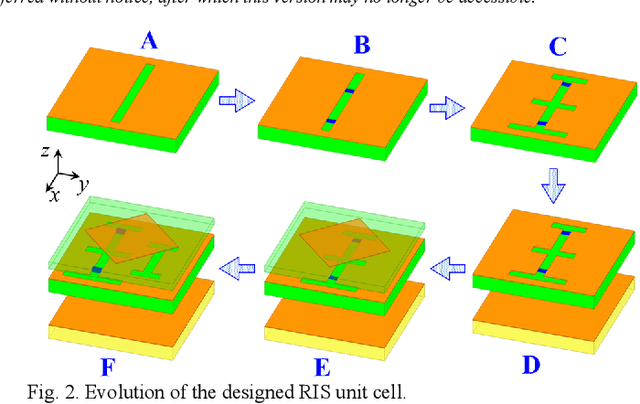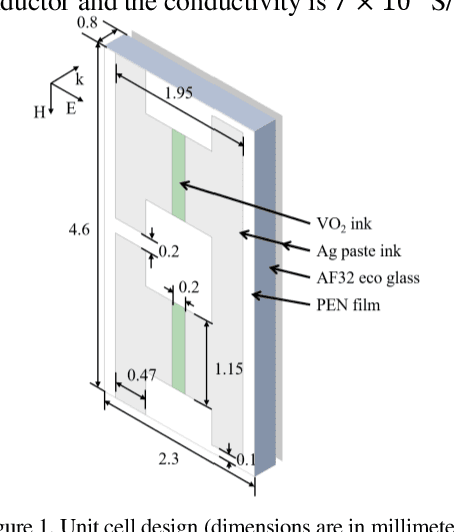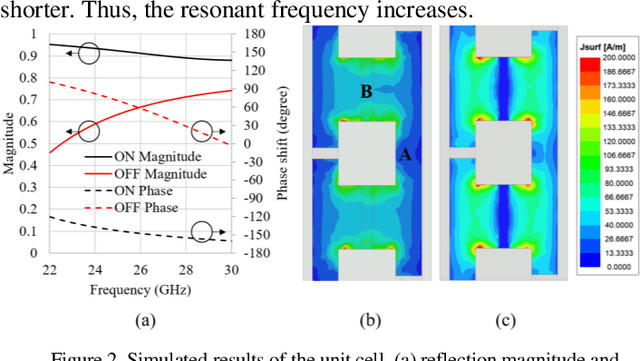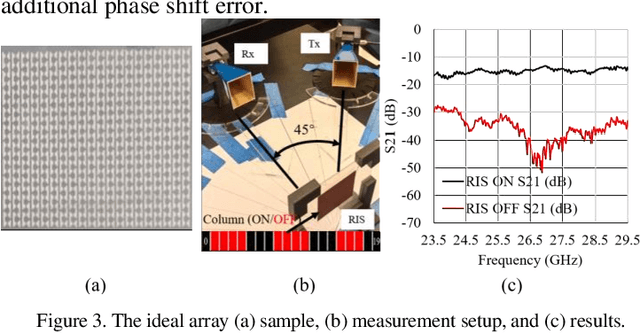Atif Shamim
CEMSE Division, King Abdullah University of Science and Technology
Electromagnetically Reconfigurable Fluid Antenna System for Wireless Communications: Design, Modeling, Algorithm, Fabrication, and Experiment
Feb 27, 2025



Abstract:This paper presents the concept, design, channel modeling, beamforming algorithm, prototype fabrication, and experimental measurement of an electromagnetically reconfigurable fluid antenna system (ER-FAS), in which each FAS array element features electromagnetic (EM) reconfigurability. Unlike most existing FAS works that investigate spatial reconfigurability, the proposed ER-FAS enables direct control over the EM characteristics of each element, allowing for dynamic radiation pattern reconfigurability. Specifically, a novel ER-FAS architecture leveraging software-controlled fluidics is proposed, and corresponding wireless channel models are established. A low-complexity greedy beamforming algorithm is developed to jointly optimize the analog phase shift and the radiation state of each array element. The accuracy of the ER-FAS channel model and the effectiveness of the beamforming algorithm are validated through (i) full-wave EM simulations and (ii) numerical spectral efficiency evaluations. Simulation results confirm that the proposed ER-FAS significantly enhances spectral efficiency compared to conventional antenna arrays. To further validate this design, we fabricate hardware prototypes for both the ER-FAS element and array, using Galinstan liquid metal alloy, fluid silver paste, and software-controlled fluidic channels. The simulation results are experimentally verified through prototype measurements conducted in an anechoic chamber. Additionally, indoor communication trials are conducted via a pair of software-defined radios which demonstrate superior received power and bit error rate performance of the ER-FAS prototype. This work presents the first demonstration of a liquid-based ER-FAS in array configuration for enhancing communication systems.
A 2-bit Wideband 5G mm-Wave RIS with Low Side Lobe Levels and no Quantization Lobe
Feb 22, 2025



Abstract:Reconfigurable intelligent surface (RIS) with 1-bit phase resolution suffers from high side lobe levels (SLLs) in the near field and pronounced quantization lobe levels (QLLs) in the far field, which is detrimental for the quality of wireless communication. RIS design is further challenging in the mm-wave bands, where typically large bandwidths are required. To address these limitations, this work proposes a novel wideband 5G mm-Wave RIS with 2-bit phase quantization, capable of covering the entire 5G n258 band. The proposed unit cell design is a combination of a grounded main slot, a parasitic slot, and a coupling patch, utilizing only two PIN diodes. This design achieves a 2-bit bandwidth (BW) of 24.1--27.7 GHz (13.9\%) and an effective 1-bit BW of 20.0--28.9 GHz (36.4\%). The unit cell features a compact size of 0.39$\lambda$ $\times$ 0.39$\lambda$, providing decent angular stability of $\pm30^\circ$ as well as eliminating the grating lobes. Based on this unit cell design, a 20 $\times$ 20 RIS array has been designed, fabricated, and experimentally characterized. The measured results demonstrate that, within the 5G n258 band, the proposed 2-bit 5G mm-Wave RIS achieves an SLL of -15.4 dB in the near field, representing a 7.6 dB improvement compared to its 1-bit counterpart. Furthermore, it has almost negligible QLL (-14.6 dB) in the far field, providing a suppression of 13.3 dB relative to the 1-bit design. Thus, the proposed 2-bit mm-Wave RIS offers wideband performance, low SLL, negligible QLL, decent angular stability, and a broad beam scanning range of 50$^\circ$, making it a promising solution for high-resolution and low-interference mm-Wave wireless communication systems.
A Fully Screen-Printed Vanadium-Dioxide Switches Based Wideband Reconfigurable Intelligent Surface for 5G Bands
Apr 30, 2024Abstract:Reconfigurable Intelligent Surface (RIS) is attracting more and more research interest because of its ability to reprogram the radio environment. Designing and implementing the RIS, however, is challenging because of limitations of printed circuit board (PCB) technology related to manufacturing of large sizes as well as the cost of switches. Thus, a low-cost manufacturing process suitable for large size and volume of devices, such as screen-printing is necessary. In this paper, for the first time, a fully screen-printed reconfigurable intelligent surface (RIS) with vanadium dioxide (VO2) switches for 5G and beyond communications is proposed. A VO2 ink has been prepared and batches of switches have been printed and integrated with the resonator elements. These switches are a fraction of the cost of commercial switches. Furthermore, the printing of these switches directly on metal patterns negates the need of any minute soldering of the switches. To avoid the complications of multilayer printing and realizing the RIS without vias, the resonators and the biasing lines are realized on a single layer. However, this introduces the challenge of interference between the biasing lines and the resonators, which is tackled in this work by designing the bias lines as part of the resonator. By adjusting the unit cell periodicity and the dimension of the H-shaped resonator, we achieve a 220 to 170{\deg} phase shift from 23.5 GHz to 29.5 GHz covering both n257 and n258 bands. Inside the wide bandwidth, the maximum ON reflection magnitude is 74%, and the maximum OFF magnitude is 94%. The RIS array comprises 20x20 unit cells (4.54x4.54{\lambda}^2 at 29.5 GHz). Each column of unit cells is serially connected to a current biasing circuit. To validate the array's performance, we conduct full-wave simulations as well as near-field and far-field measurements.
Mutual Coupling in RIS-Aided Communication: Experimental Validation and Performance Evaluation
Nov 17, 2023



Abstract:This paper explores the mutual coupling in the reconfigurable intelligent surface (RIS)-aided communication. Despite the existence of several mutual coupling-aware models for RIS-aided communication, a notable gap remains due to the lack of experimental validation. This paper bridges this gap by first introducing a novel model training approach based on the 3D full-wave simulation and subsequently validating the obtained model via experimental measurements in a 1-bit quasi-passive RIS prototype operating in the mmWave band. Comparative analyses reveal precision in both the employed mutual coupling-aware model and the assessed model parameters, offering a realistic evaluation of mutual coupling in authentic RIS hardware. Utilizing the validated mutual coupling-aware communication model, we systematically examine the impact of mutual coupling on communication performance by adopting the achievable rate as a performance indicator. Our results reveal that the mutual coupling in RIS exhibits heightened significance with increased RIS amplitude gains and showcases a frequency-dependent effect.
A Wideband Reconfigurable Intelligent Surface for 5G Millimeter-Wave Applications
Apr 23, 2023Abstract:Despite the growing interest in reconfigurable intelligent surfaces (RISs) for millimeter-wave (mm-wave) bands, and the considerable theoretical work reported by the communication community, there is a limited number of published works demonstrating practical implementations and experimental results. To the authors' knowledge, no published literature has reported experimental results for RISs covering the n257 and n258 mm-wave bands. In this work, we propose a novel wideband RIS design that covers the entire mm-wave 5G n257 and n258 bands. In simulations, the unit cell can maintain a phase difference of 180{\deg} +- 20{\deg} and a reflection magnitude greater than -2.8 dB within 22.7 to 30.5 GHz (29.3% bandwidth) using one-bit PIN switches. The proposed unit cell design with four circular cutouts and long vias could realize wideband performance by exciting two adjacent high-order resonances (2.5f and 3.5f). The periodic unit cells can maintain an angular stability of 30{\deg}. Based on the proposed unit cell, a 20 by 20 RIS array is designed and fabricated with a size of 7.1{\lambda} by 7.1{\lambda}. The measurement results demonstrate that the proposed RIS could maintain a 3 dB peak gain variation bandwidth among various array configurations within 22.5 to 29.5 GHz (26.9%) and with a beam scanning capability of 50{\deg}, making this design a good candidate for 5G mm-wave applications.
A Via-less Fully Screen-Printed Reconfigurable Intelligent Surface for 5G Millimeter Wave Communication
Feb 07, 2023


Abstract:In this paper, we propose a via-less fully screen-printed reconfigurable intelligent surface which can establish a second line-of-sight communication from 23.5GHz to 29.5GHz. By serially connecting the H shaped resonator along the H field of the incident wave, we minimize the effect of the biasing lines and make a via-less design, which reduces the fabrication difficulty and cost. The unit-cell simulation of the array with screen-printed VO2 switches shows a 215{\deg} to 160{\deg} phase shift difference between the ON and OFF states within bandwidth. During the field testing of the ideal arrays, we verify that the array can redirect the 45{\deg} incident wave to 0{\deg} reflection with a signal enhancement of at least 10 dB as compared to the array which has all unit cells in the OFF condition.
 Add to Chrome
Add to Chrome Add to Firefox
Add to Firefox Add to Edge
Add to Edge